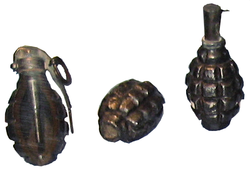F1 grenade (France)
This article needs additional citations for verification. (September 2013) |
| Fusante No.1 Grenade | |
|---|---|
 From left to right: F1 with M1916 Billant fuse, F1 body, F1 with percussion fuse. | |
| Type | Percussion, time-fused grenade |
| Place of origin | France |
| Service history | |
| In service | 1915–1940[1] |
| Used by | |
| Wars | |
| Production history | |
| Designer | Thuau Fils |
| Designed | 1915 |
| Produced | 1915–1940 (France) |
| No. built | Approx. 60,000,000 |
| Specifications | |
| Mass | 530 g (19 oz), 550 g (19 oz), 570 g (20 oz), 600 g (21 oz) trinitrotoluene (TNT) |
| Filling weight | 60 g (2.1 oz) |
Detonation mechanism | MLE14 lighter, MLE15 percution, MLE16 percution, MLE16 Billant, MLE18 Bourny, MLE35 Bourny |
The F-1 grenade is a
Overview
The F-1 grenade was first put into mass production by the French State in 1915 during the First World War. In May 1915 the first of the F1 grenades (fusante No. 1) appeared in the French military, in limited quantities. This new weapon inherited from the experience of the first months of the war: the shape was made to be more modern, with an external grooves pattern for better grip and easier fragmentation. The second expectation proved deceptive, since the explosion in practice gave no more than 10 fragments (although the pattern was designed to split into all the 38 drawn divisions). The design was proved to be very functional, especially due to its stability compared to other grenades of the same period. Later, the Fusante No. 1 was used en masse by many foreign armies in the period 1915–1940. The F-1 grenade has been used as a basis for the development of many other grenades by different nations, including the US and the Soviet Union.
The F-1 was very widespread during the first half of the 20th century, used by armies of France, United States, Imperial Russia, the Soviet Union, Finland, and others. Overall more than sixty million of these grenades were produced over 25 years, from 1915 to 1940.
Development

Originally, the F1 was designed to use a lighter-based ignition system, but later it began using a
United States
The French F-1 grenade with the M1916 Billant fuse was the preferred grenade of the
Russian Civil War
During the Russian Civil War, the F1 was both given to the
See also
References
- ^ Bernard Plumier (29 March 2004). "Passion & Compassion 1914-1918: WW1 militaria and technical documentation - French grenades". Passioncompassion1418.com. Retrieved 18 September 2012.
- ^ "Finnish Junkyard". Saunalahti.fi. Archived from the original on 7 November 2015. Retrieved 18 September 2012.
- ^ Murohovskij, V. I. (1992). Infantry Weaponry. Moscow: Arsenal-Press.
- ^ Eremeev, Yurij. "Army Anatomy". army.armor.kiev.ua. Retrieved 13 November 2014.
External links
